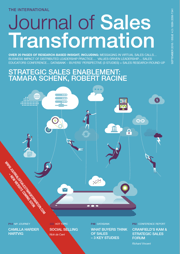 The primary goal of sales enablement must surely be to increase sales effectiveness by progressively reducing the performance gap between our best sales people and the rest, measured by revenue and other tangible metrics.
The primary goal of sales enablement must surely be to increase sales effectiveness by progressively reducing the performance gap between our best sales people and the rest, measured by revenue and other tangible metrics.
But it seems to me that a number of sales enablement programmes (typically the less successful ones) have made insufficient efforts to understand the winning behaviours of their top sales performers, or to package these learnings into simple practical and usable tools that can equip competent but otherwise under-performing sales people to embrace these best practices.
It’s a mistake to assume that top performance is largely driven by innate personal abilities that cannot be coached or taught. Of course, that’s often a contributing factor but let’s not ignore another key attribute of top performers: they often have a particularly well-developed ability to learn from their experiences and to adapt their behaviours accordingly.
They avoid repeating the same mistakes, and they are continually on the look-out for new ideas, tactics and techniques that will serve to improve their sales performance. It’s true that they sometimes appear to be “unconsciously competent” when directly asked about what they do differently, but in my experience a combination of intelligent questioning and thoughtful observation can uncover the secrets behind their success.
Their winning formula almost always includes some predictable elements: for example, they have typically learned through experience which issues, organisations and roles to target, and how to identify the trigger events that signal that it is the right time to engage one of these prospective customers.
Top performers typically use these often often-informal “ideal customer profiles” to assess inbound leads as well, but they also shine in the quality of their opportunity qualification. They know what to look for, they qualify hard and often, and they are unafraid to discard poorly qualified opportunities because they know that their time can be better spent elsewhere.
The discovery process is, of course, a key part of this qualification exercise. It’s my observation that top performers invest more time in discovery, ask better questions, listen more effectively and drill more deeply into their prospective customer’s issues, opportunities, risks and obstacles.
They take the time to understand the consequences of all of these factors on the customer – and often are able to introduce fresh insights that help their prospect to recognise the need for urgent action. They resist the itch to pitch their “solution” prematurely – and when they do, they tend to be much more effective than their peers at connecting the business value of their solution with the business issues and priorities of their customers.
And one more thing – they tend to be much better at handling objections. This is partly down to their ability to pre-empt many potential objections, but they have also learned how to deal with many of their customers frequently asked and potentially tough-to-answer questions.
What has all of this got to do with sales enablement? To my mind, it lies at the very heart of the function. Our sales enablement programmes must reflect the winning habits and hard-won lessons of our top sales performers. They must reflect real-life experience, and incorporate simple and effective training, tools and checklists to help the averagely competent sales person put them into practice.
Our core sales enablement materials and messages must feel like they reflect the accumulated experience of the most highly-regarded members of the sales team rather than content that appears to have been made-up by some “expert” in marketing without sufficient regard for the real world of selling.
That means that our sales enablement programmes must include the active involvement and participation of our most respected sales performers. Without them, we run the risk of producing a bunch of content that might look attractive but which neither changes sales behaviours nor significantly improves sales performance. And that feels to me like something of a wasted opportunity…
This article was first published in the September 2018 issue of the International Journal of Sales Transformation. For a limited period, you can sign up for a free digital subscription to this excellent publication.




Thanks for advocating for the involvement of high performing sales reps in an enablement program, Bob. I completely agree that these employees are a great asset to a team and their knowledge and expertise should be leveraged. We’ve also found that the best sales enablement tools involve an element of practice. It gives both high performers and new reps a great opportunity to improve their skills, reinforce best practices, and increase knowledge retention. We’ve used these scenarios for product pitches and demos and for those objections you mentioned. It’s been a great way for our high performers to coach and help other reps and it’s really made an impact on the performance gap!